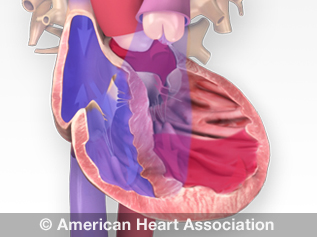Types of Heart Failure
Quick Facts
- There are different types of heart failure. It depends on which part of the heart not working well.
- Congestive heart failure (CHF) is a form of heart failure in which the heart cannot pump enough blood to meet the body’s needs.
Left-sided heart failure
The heart pumps oxygen-rich blood from the lungs to the left atrium. Then it goes to the left ventricle, which pumps the blood to the rest of the body. The left ventricle does most of the heart’s pumping, so it’s larger than the other chambers. It is essential for the heart to function normally.
In left-sided, or left ventricular, heart failure, the left side must work harder to pump the same amount of blood. The amount of blood the heart can pump with each beat is measured by something called ejection fraction, or EF. A normal EF is about 55% to 60%.
Watch an animation of heart failure.
There are two types of left-sided heart failure:
- Systolic failure: The left ventricle doesn’t contract normally. The heart can’t pump enough blood into circulation. This is also known as heart failure with reduced ejection, or HFrEF. When this happens, the heart is pumping less than or equal to 40% EF.
- Diastolic failure: The left ventricle can’t relax normally because the muscle has become stiff. The heart can’t fill with blood as is should during the time between each beat. This is also known as heart failure with preserved ejection, or HFpEF. When this happens, the EF is 50% or higher. Heart failure with mildly reduced ejection fraction (HFmrEF) is a newer concept. In this type of heart failure, the EF is between 41% and 49%. This places people with HFmrEF between the HFrEF and HFpEF groups.
Right-sided heart failure
The heart’s pumping action moves blood that has no more oxygen in it back to the right atrium and on to the right ventricle. The right ventricle then pumps the blood back out of the heart and into the lungs to get fresh oxygen.
Right-sided, or right ventricular, heart failure often happens due to left-sided failure. When the left ventricle fails and can’t pump enough blood out, increased fluid pressure is pushed back through the lungs. This damages the heart’s right side. When the right side loses pumping power, blood backs up in the veins.
Biventricular heart failure
With biventricular heart failure, both the left and right sides of the heart are affected. This can cause the same symptoms as left-sided and right-sided heart failure. Some of these include:
- Shortness of breath
- Buildup of extra fluid in body tissues (edema)
- Tiredness, fatigue
Is heart failure the same as congestive heart failure?
Congestive heart failure, sometimes called CHF, is heart failure that includes fluid buildup in the body. Congestive heart failure requires quick medical care.
When the heart pumps less blood, blood coming back to the heart through the veins backs up. This causes congestion in the body’s tissues. Swelling, known as edema, often results. Swelling usually happens in the legs and ankles, but it can happen in other parts of the body, too.
Fluid sometimes builds up in the lungs, making it hard to breathe, causing shortness of breath, especially when lying down. This is called pulmonary edema. If left untreated, it can cause respiratory distress.
Heart failure also affects how the kidneys get rid of sodium and water. This results in more blood volume. This retained water also causes more swelling in the body's tissues.







